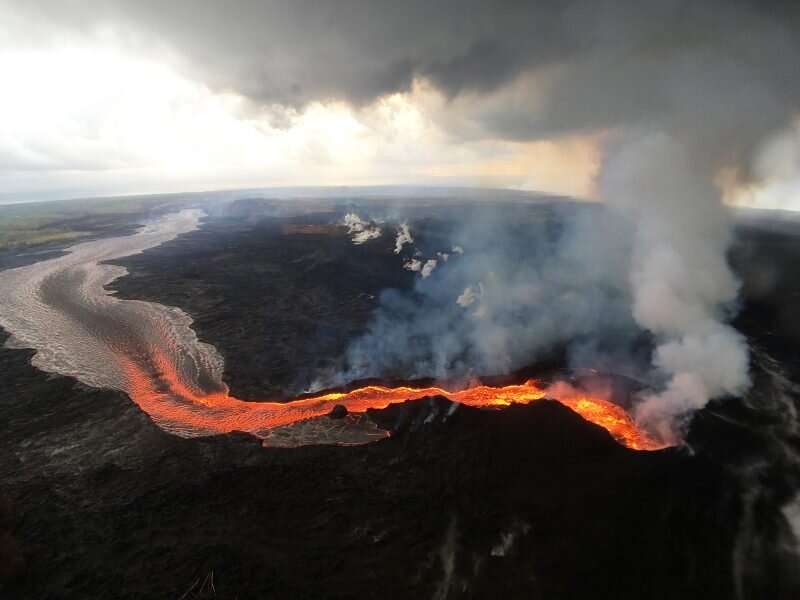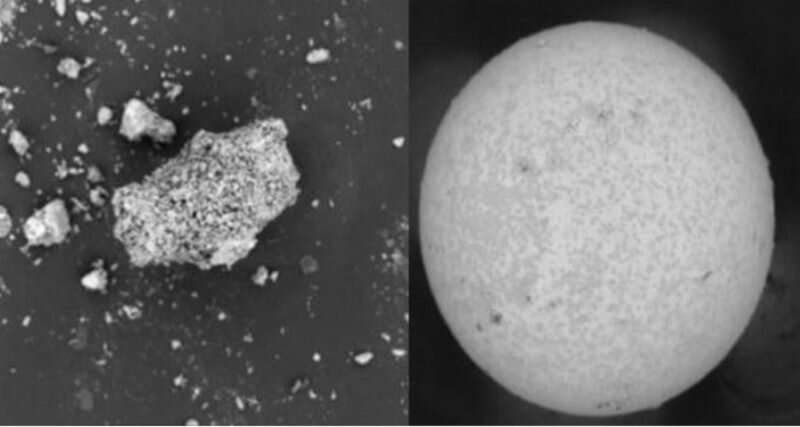Shape of volcanic ash influences contamination of water sources in volcanically active regions

Contaminants from volcanic eruptions leach into water at different rates depending on the shape of the volcanic ash particles, according to new research that could enhancing scientists' ability to predict water quality risk in volcanically active regions.
Volcanic ash consists of microscopic fragments of solidified magma propelled from volcanic eruptions. When a volcano erupts, ash can travel great distances. In the short term, ash can contaminate vegetation, surface water, soils and groundwater with heavy metals like copper, cadmium and arsenic and non-metal contaminants like fluorine.
These contaminants can enter the food chain in a process known as bioaccumulation. Bioaccumulation occurs when organisms ingest and store contaminants that they cannot metabolize. These contaminants can become more concentrated as they travel up the food chain, poisoning livestock and humans. Bioaccumulation of heavy metals can cause some cancers, while bioaccumulation of non-metals like fluorine can cause skeletal damage.
A new study in AGU's journal GeoHealth finds ash particles' surface area controls how quickly ash leaches contaminants into the water. The more bubbles a particle has—or the more porous it is—the larger its surface area. Ash with more bubbles leaches faster, because it has more surface for water to permeate.
The results suggest particle structure can affect water quality, improving geologists' ability to predict how environments might respond to volcanic explosions. Understanding how ash types influence the way contaminants dissolve in water enables scientists to predict the health hazards imposed by water contamination in regions with frequent volcanism, according to the study's authors.

"The first couple of hours are when water is the most contaminated and the leaching rates decline afterwards. However, the long term, repeated eruptions can lead to bioaccumulation," said Candace Wygel, a geologist who conducted the research while a graduate student at Lehigh University in Bethlehem, Pennsylvania. Wygel, now a geologist at Roux Environmental Engineering and Geology D.P.C. in New York City, New York, is the lead author of the new paper.
Measuring bubble concentration
Previous studies of volcanic ash assumed each particle was uniformly spherical and compact. This method didn't account for how porous some types of ash are. For example, particles from andesitic ash, a type of volcanic ash with medium-grained crystals and medium silica content, may have many microscopic bubbles. Each bubble increases the surface area of the ash sample. More water can touch the sample and dissolve its contaminants.
In addition, different types of volcanic ash have unique concentrations of elements and contaminants. Basaltic ash, a type of volcanic ash low silica content, contains more metals than andesitic ashes. However, since andesitic ash has more bubbles, it leaches what it has faster. Scientists knew chemical composition influenced what volcanic ash leached, but Wygel and her colleagues suspected particle structure also impacts ashes' leaching rate.
"We wanted to see how the morphology of the ash impacted leaching into the environment," Wygel said.
In the new study, the researchers collected samples from four volcanoes in Hawaii, Costa Rica, Alaska and Iceland. Each volcano erupted primarily basaltic or andesitic ash. The researchers measured each sample's total surface area and accounted for bubbles inside the ash. They found the samples had surface areas about three times larger than when they were measured with the standard geometric method.
They found ash particles with larger surface areas leached metals faster. Over seven days, water eroded the particles, making their surface areas smaller and changing their leaching rates. The researchers took surface area measurements at different points in time to observe how ashes' leaching rates changed from water weathering.
Andesitic ash from the Costa Rican volcano Turrialba had the highest leaching rate, attributed to its high concentrations of bubbles. Turrialba's ash initially leached contaminants fastest. However, basaltic ash from the Hawaiian volcano, Kilauea, leached the greatest concentrations of metals. The results suggest ashes' leaching rate and chemical composition affect environments in tandem.
More information: C.M. Wygel et al. Bubbles and Dust: Experimental Results of Dissolution Rates of Metal Salts and Glasses from Volcanic Ash Deposits in Terms of Surface Area, Chemistry, and Human Health Impacts, GeoHealth (2019). DOI: 10.1029/2018GH000181
Provided by American Geophysical Union




















